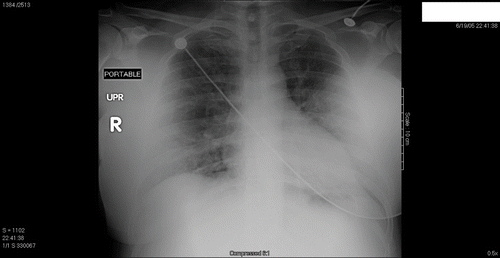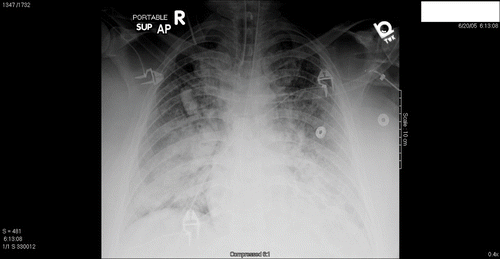Abstract
Background. Silicone is an inert liquid polymer often chosen for cosmetic procedures due to its durability and thermal stability. Following silicone injection, end organ toxicity can occur. We report two cases of multiorgan dysfunction following silicone injection. Case report. Two transsexual males presented to the emergency department with altered consciousness after receiving subcutaneous injections of silicone into the hip and buttocks. Each patient had received injections totaling between one and two liters of silicone. Soon after the injections, each reported feeling nauseated and lethargic, and then lost consciousness. On arrival, each was somnolent, with tachycardia and hypotension. Lungs were clear and there were multiple injection sites of induration noted over the hips and gluteal regions. Laboratory screening showed leukocytosis and hemoconcentration in each, with no drugs found on urine toxicology screening. Chemistries were normal. Both became hypoxic on arterial blood gas analysis. Oxygenation worsened in each despite intubation and ventilator manipulation. Chest radiographs were initially clear but progressively showed adult respiratory distress syndrome. One patient gradually improved over several days, was extubated, and recovered neurologically. The second patient continued to be hypoxic, never regained neurologic function, and expired three weeks after presentation. Post-mortem examination revealed clinical respiratory failure with organizing pneumonia, adult respiratory distress syndrome, and foreign body giant cell reactions to silicone. Additionally, multiple small subacute brain white matter infarcts consistent with silicone embolization were found. Conclusion. Clandestine application of silicone for body enhancement is common and clinicians should be aware of the potential complications.
Keywords:
Introduction
Silicone is a chemically inert liquid polymer often chosen for cosmetic procedures due to its durability and thermal stability. The illicit use of silicone injections is common in some populations, such as transsexuals (Citation1). Case reports of silicone injection have described adverse pulmonary reactions, including diffuse alveolar damage, pneumonitis, and acute adult respiratory distress syndrome (ARDS) (Citation1–9). We report two cases of multiple organ dysfunction following silicone injection.
Case reports
Five transsexual males employed a woman to attend a “pumping party” at their residence. The woman arrived at the residence in the afternoon with the intention of injecting 1 to 2 liters of hospital grade silicone into the thighs and buttocks of two of the attendees, patients 1 and 2 below, while injecting smaller quantities into the face and lips of the other three individuals. Each had previously received silicone injections into the face and lips without complications.
Approximately four hours after the injections, 911 operators were called from the residence because the two individuals who received the larger injections were having difficulty breathing. These two were transported to an Emergency Department (ED), while the other three individuals were unaffected. Police later responded to the residence and found pre-filled syringes of silicone that had been emptied. A warrant was issued for the arrest of the person who injected the silicone.
The two symptomatic patients arrived at the ED with altered consciousness, diaphoresis and nausea, which had apparently been present since they received injections into their hips and buttocks earlier that afternoon.
Patient 1
The first patient was a 45 year old male with a history of HIV (most recent viral load of less than 400 copies). On arrival to the ED, he was arousable and could answer questions. He denied chest pain or shortness of breath, but reported a slight headache as well as dizziness and a cough. He also denied any recent ethanol or drug use, and his only medications were antiretroviral drugs.
The patient was diaphoretic and lethargic. His vital signs were temperature 102o F, pulse 135 beats/minute, respiratory rate 14 breaths/minute, blood pressure 103/76 mmHg, and oxygen saturation 89% on 4 liters of oxygen by nasal cannula. On physical examination, the patient was noted to have “plasticity” to his cheeks and lips. His neck was supple. Except for tachycardia, his cardiac and abdominal examinations were unremarkable and his lungs were clear. Extremity examinations did not show any infections, rashes or cyanosis, but he had extensive swelling and edema of the hips bilaterally over the greater trochanter without erythema. These areas also had a somewhat “doughy” consistency on palpation. His neurologic examination was grossly nonfocal but limited due to the patient's inability to comply with testing.
Initial laboratory analysis revealed a white blood cell count (WBC) of 12,300/mm3, and hemoglobin of 18.6 g/dL. Serum glucose and chemistry tests were unremarkable. Urine toxicology screening for drugs of abuse and blood analysis for acetaminophen and salicylate were all negative, as were cardiac enzymes. Initial chest radiographs and an electrocardiogram were both normal (), but arterial blood gas (ABG) analysis results on supplemental oxygen with 6 liters by nasal cannula were a pH 7.37, pCO2 38 mmHg, pO2 61 mmHg and oxygen saturation 90%.
Over the next 2 hours, the patient's pulmonary function rapidly decompensated, with oxygen saturations dropping to less than 70% despite more than 10 liters of supplemental oxygen by face mask. He was intubated, and transferred to the intensive care unit (ICU). He also became and remained obtunded.
At this point, intravenous methylprednisolone was begun and administered every six hours. His blood pressure decreased and he was begun on a norepinephrine infusion. Over the next 5 hours, ventilations became more difficult with increasing peak pressures and his oxygenation deteriorated. A repeat chest radiograph showed bilateral pulmonary infiltrates (). ABG analysis results on 100% oxygen at this time were pH 7.17, PaCO2 58 mmHg, PaO2 39 mmHg and oxygen saturation of 68%.
The patient continued to be hypoxic and ventilator-dependent with no improvement in neurological status over several days. On hospital day 10 he had a tacheostomy placed, and bronchoscopy on hospital day 11 revealed edematous swollen airways with obscured lower lobe bronchi. Secretions were bloody and purulent, but cultures were negative for bacteria, fungi, mycobacteria, pneumocystis, and viruses. Cytology of bronchial fluid showed only inflammatory cells. Fungal serologies were negative. Computerized tomography of the brain done several times throughout the hospitalization showed possible mild edema but no other focal findings. On hospital day 19, in consultation with neurology, the patient was weaned off of all sedation but remained obtunded. After a family conference on hospital day 22, he was provided palliative care only, and died the same day following removal from the ventilator.
Post-mortem examination revealed clinical respiratory failure with organizing pneumonia, ARDS, and foreign body giant cell reactions to round optically clear material consistent with silicone emboli. Similar appearing round optically clear profiles were also present in the heart and kidneys suggesting systemic emboli. Additionally, multiple small subacute brain white matter infarcts consistent with silicone embolization were found on brain histology. Dissection of the hip and buttock areas revealed abundant viscous clear material consistent with silicone along with fibrosis and scarring.
Patient 2
This patient had no past significant medical history and denied drug or alcohol use. His presenting vital signs were pulse 103 beats/minute, respiratory rate 18 breaths/minute, blood pressure 98/64 mmHg, and oxygen saturation 100% on room air. His physical examination was remarkable only for tense swelling of each hip without erythema or signs of infection. Neurologic testing demonstrated no focal findings other than lethargy.
Initial laboratory analysis were WBC14,300/mm3 and hemoglobin 19 g/dL. His glucose was 133 mg/dL and other chemistries were normal. Urine drugs of abuse screen and measurements for acetaminophen and salicylate were negative, and his initial chest radiograph was unremarkable.
The patient developed worsening pulmonary function during initial observation period requiring intubation and ICU admission. His chest radiograph gradually worsened to show mild pulmonary infiltrates, but his oxygen requirement remained stable. He gradually recovered normal pulmonary function, was successfully extubated on hospital day 10, and eventually recovered.
Discussion
The predominant manifestations of silicone toxicity by inhalation or injection include hypoxemia, dyspnea, fever, alveolar hemorrhages, cough, and altered level of consciousness. A previous report described two forms of silicone-induced pneumonitis in eight transsexual men, an acute form occurring within days of injection, and a delayed reaction seen up to a year and a half after injection (Citation1). Although the precise mechanism of toxicity in unclear, a correlation between these findings and those of fat emboli syndrome has been suggested (Citation1). This theory suggests that small particles of silicone gradually diffuse into the circulatory system with subsequent embolization to the lungs (Citation2). These authors also suggest two prominent clinical presentations, one with mostly pulmonary toxicity from which most patients recover and a second dominated mostly by neurologic toxicity where most of the cases resulted in death (Citation2).
Although the patients in this report exhibited some of the classic manifestations of silicone embolism on presentation, not all of the usual findings, such as cough, were present in each. It is possible that patient 2 developed lethargy so rapidly following injection that he could not produce a cough. Pulmonary signs and toxicity in both individuals appeared to somewhat lag behind CNS manifestations on presentation, and their initial chest radiography and pulmonary examinations were benign. Two potential reasons for this delayed time course would be the gradual release of more silicone emboli from the source areas leading to greater lung involvement, or a slow leak of fluid into alveoli precipitated by the emboli that progressed on to ARDS. A similar manifestation and time course can be seen with heroin-induced pulmonary edema.
Another interesting initial finding in our cases was hemoconcentration. The mechanism of their elevated hemoglobin concentrations is unclear, but could represent third-spacing of intravascular fluid in various tissues of the body due to the embolism syndrome, or some type of stress response.
Conclusion
We present two cases of toxicity following massive subcutaneous silicone injection. Large volume silicone injections can lead to damage particularly to the pulmonary and nervous systems. This syndrome likely occurs from embolization of silicone to the brain, lungs, and possibly other organs.
References
- A Schmid, A Tzur, L Leshko, and BP Krieger. Silicone embolism syndrome. Chest 2005; 127:2276–2281.
- J Chastre, P Brun, P Soler, F Basset, and et al Acute and latent pneumonitis after subcutaneous injections of silicone in transsexual men. Am Rev Respir Dis 1987; 135:236–240.
- Y-F Lai, TY Chao, and SL Wong. Acute pneumonitis after subcutaneous injections of silicone for augmentation mammoplasty. Chest 1994; 106:1152–1155.
- T Duong, AJ Schonfeld, M Yungbluth, and R Slotten. Acute pneumopathy in a nonsurgical transsexual. Chest 1998; 113:1127–1129.
- R Ellenbogen, R Ellenbogen, and L Rubin. Injectable fluid silicone therapy. JAMA 1975; 234:308–309.
- KY Chung, SH Kim, IH Kwon, YS Choi, and et al Clinicopathologic review of pulmonary silicone embolism with special emphasis on the resultant histologic diversity in the lung – a review of five cases. Yonsei Med J 2002; 43:152–159.
- YM Chen, CC Lu, and RP Perng. Silicone fluid-induced pulmonary embolism. Am Rev Respir Dis 1993; 147:1299–1302.
- BR Celli, and DM Kovnat. Acute pneumonitis after subcutaneous injections of silicone. NEJM 1983; 309:856–857.
- J Chastre, F Basset, F Viau, P Dournovo, and et al Acute pneumonitis after subcutaneous injections of silicone in transsexual men. NEJM 1983; 308:764–765.


